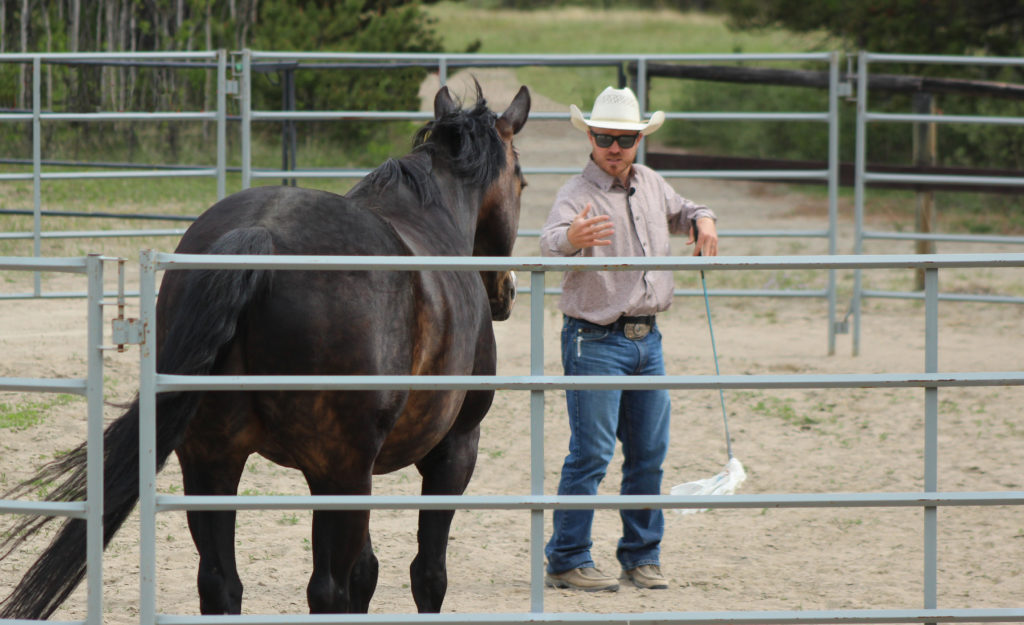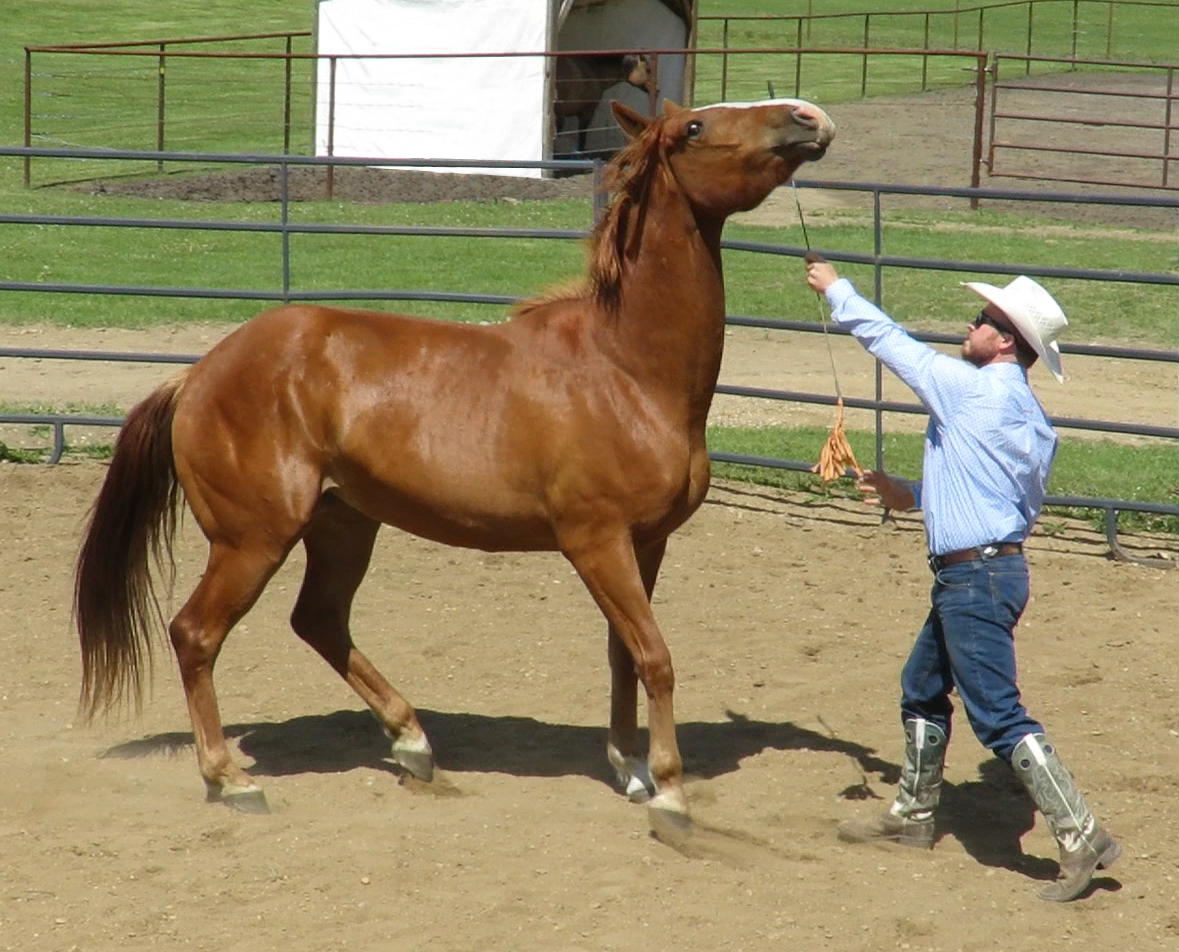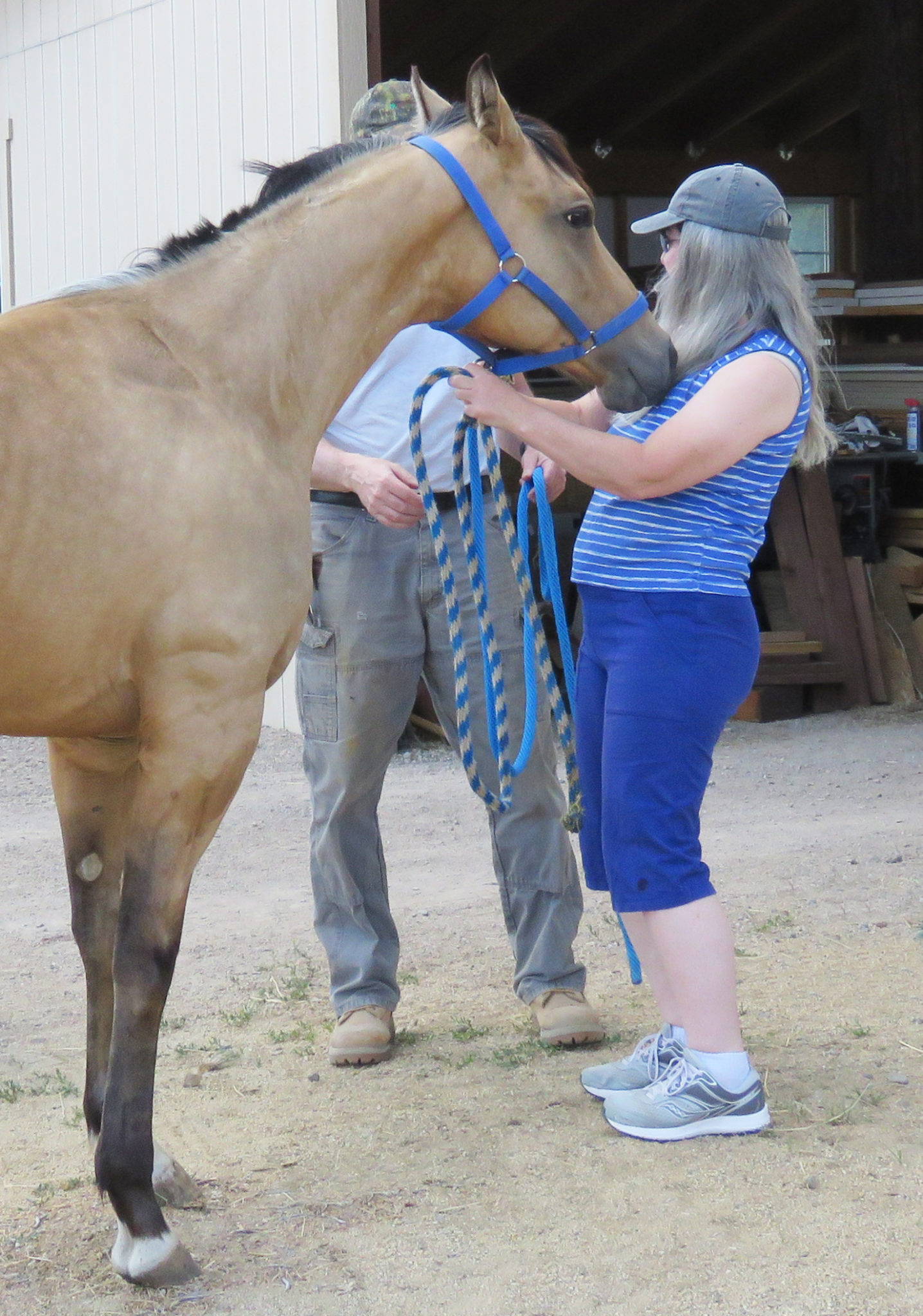In my last couple of posts, we’ve been looking at how to begin working in the round pen with “Mind” horses and “Pressure” horses. Today, I’ll explain how I use the round pen to start a conversation with a “Space” horse.
While there are some similarities in the beginning work with a Pressure horse and a Mind horse, your first steps in the round pen are usually different when working with a Space horse. These horses are usually mentally present, not fearful of pressure, and they are very willing to enter your space because they are looking for spatial interaction. They are the only type of horse where your first round pen conversation will likely involve directing the horse to move away from you.
It is very common for people to label a Space horse as dominant or rude, but I believe they simply have a strong need for clarity regarding your relationship and your intentions. When they ask for clarification by engaging you spatially, you can choose to interpret this either of two ways. You can see their actions as disrespectful or threatening, in which case you will likely respond emotionally (see previous posts on “Emotional Horsemanship”) and feel justified in “getting after” them. Or, you can interpret their engagement as an invitation to a conversation, which is a golden opportunity for you to establish a great foundation for your relationship. Here is how I would go about this:

When working with Space horses, we need to be very aware of what kind of energy we present within our own space. If you embody your space with confidence, awareness and peace, the horse will feel this and gain comfort from it.
First, you need to give some real thought to your own personal space and what kind of energy or “presence” you project into it. This is very important, as the idea of space within Relational Horsemanship is not about “being the boss” or who moves whom, but about who has a deeper sense of confidence, awareness and peace within their space. When you have these strengths, they fill you with a presence that the horse can feel, and it gives the horse a sense of security. The spatial conversation is then one in which the horse gains awareness of who you are within your own space, not one about the human concept of “respect”.
Next, you need to figure out which part of its body the horse tends to use when attempting to engage your space. Some will come in more strongly with their nose or shoulders, and some will be more expressive with their hindquarters. If the horse is the front end type, the first thing I am going to do is ask the horse to yield the front end away from me, and I will then turn the horse into the fence, which helps establish yield in the nose/shoulders.
Now, just a quick note on turning a horse into the fence: I am aware that there are people who say that you should never turn a horse into the fence, as that puts its hindquarters towards you, which they believe is “disrespectful”. But I have found that when a horse tends to get strong with its front end, it is actually very helpful to turn them in this way in the beginning. The fact is that one-size-fits-all ideas that tell us we should always do this or never do that can sometimes lead us down the wrong path, as we need to see and address what the horse is actually presenting, rather than sticking to prescribed, mechanical methods. It is important to recognize that horses can turn towards you with or without softness, and they can turn away from you with or without softness, so I am looking for how they yield, whichever way I direct them.

This horse was engaging my space with her nose and shoulder, so I asked her to yield those parts away from me. As you can see, she did not do this easily at first, but I remained calm, clear and consistent in my conversation with her, so it soon became much easier for her to soften to my requests.
That said, when you are working with a horse that is strong with its hindquarters, you will direct pressure to move the hindquarters away and turn the horse towards you, as that is the conversation that needs to be had at that moment. Your eventual goal is that the horse becomes willing to yield both the hind end and shoulders softly, without frustration or worry. Try to remember that how they yield (softly or not) is at least as important as the yield itself, though we can’t expect perfection right away.
When we are working relationally, we also really need to keep in mind that with a Space horse, there is no disrespect in their actions, only unmet needs. If they do something like wring their neck or kick into the space, don’t take it personally or allow that to pull you into a negative frame of mind. Those behaviors will simply go away once you have met the horse’s need for clarity in your spatial communication.
If you are going to accomplish that, the Space horse requires that you begin focusing on your own spatial awareness and what you tend to do in your interactions with the horse. Say you have a tendency to be inward or “small” with your energy, or perhaps you lean or step backwards if the horse pushes into your space. You may not even realize that you do this, but you can be sure that your horse is aware of such truths in your spatial conversation. If you commonly give up your space in these ways, the horse will naturally believe that you are not the one to take care of things and “lead the dance”. You may then see the horse do various things that you might interpret as “bad attitude” or pushiness. However, most often, such behaviors are merely reminders of a contract you have already made with the horse when you yielded your space.

This handler is distracted and is not even aware that she is leaning backwards — effectively yielding space — as her young horse pushes his nose into her. You can be sure, however, that our horses notice such spatial cues at all times, so try to discover what your tendencies are and learn to own your space and stay aware whenever you are around your horses.
If you are the type of person who tends to give up your space or hold your energy down within yourself, you need to learn to own your space — but this has nothing to do with chasing the horse, being mean, or punishing undesirable behavior. It has more to do with you recognizing your tendencies and making a change within yourself that you can then communicate to the horse. One helpful exercise for this is to stand close to your horse and own your own space within yourself. You don’t need to think or do anything aggressive; just be confident about the fact that you have the right to occupy that space. Do not move — simply stand calmly and wait for the horse to feel awkward being too close to you. Soon they will move away and you will have achieved a very positive change, for you and for the horse. This is the beauty of working with a Space horse, as they will often lead us to discover a great deal about ourselves! When we fix these tendencies within us, the “bad behaviors” our Space horses present usually just disappear, and quite quickly too.
Whatever kind of horse you are working with, remember that Relational Horsemanship always strives to bring the horse into a more peaceful and connected state of mind than when you started. If things start to go sideways — and there are going to be times when they do — try not to get upset with either the horse or yourself. Just take a breath, regroup, and go back to something you know you can both feel positive about. Success will come if you aim to keep yourself centered, continue to focus on what the horse needs from you, and remember to take the time it takes.
Click HERE to check out a video in which I begin working with a Space horse who has a tendency to nip as a way to try to engage people in spatial conversations.
To learn more about working with different kinds of horses in a Relational way, visit us at JoshNichol.com.

This sure helps me in regard to my ‘space horse – standardbred’ – if he senses when I am not being fully present in myself, and weakening my own space, he will start to amplify the question…and even rear up to make his point ! Very front end pushy. And it can escalate really fast and shift into a reactive state of fear or insecurity. If I catch myself its sometimes as subtle as my shoulders slumped a bit forward and as soon as I pull my shoulders back and stand more ‘present’ he shifts his attitude and stops the questions…I SO agree with your comment about how these types of horses show us ourselves.
Excellent observations on your part, Christine. I especially like that you recognize that behaviors many people would see as “rude” or “pushy” are actually coming from a place of insecurity in your horse. Keep up the good work!
Love this article – as someone who easily finds a connection with horses that require encouragement to come into my space, I often find I’m mentally ‘off my game’ when a horse is the opposite and leans on my space. I definitely have seen my own past behavior in the photo of the woman leaning away from the horse – have been working on this by holding my own space firmly and watching for those subtle mini-steps forward horses are so good at taking when they don’t think we’re paying attention!
I am wondering if there is a way to teach people how to use their energy effectively around horses or is it something like trying to teach feel? I do know if one works with your philosophy long enough trying and leaning these things do come. Maybe I am asking if there is a way to hurry this along and having asked that question, I know the answer which is, ‘do the time.’ You do make it look easy but then I bet you are well over the 10,000 hours already.
Hi Marjorie. Learning to modulate your energy around horses is a skill that can be developed quite quickly if you focus less on what you are doing, and more on the effect you are having on the horse. If you are putting energy out into the space and the horse doesn’t seem to notice, you need to turn your energy up until the horse can feel it. If you are putting so much energy into the space that you are worrying the horse and making them feel like they need to leave, you need to tone your energy down. Horses will always tell you, with total honesty, if you are “on the right frequency” to have an effective communication with them. So, focus on the horse and adjust your presentation to what they need at that moment, and you will make progress.
Thank you. I have given this some thought after a couple of reads and think I know what will help me help the horse. I will keep you posted.
I’ve noticed that when I look down at the ground when I lead my horse, he takes advantage and tries to start a “gelding game” by chewing at the rope or grabbing my coat. If I look up and walk with intention, he gets with the program!
So…. I just realized that all three of my mares are space horses. I also just realized that I love space horses!!!!! Close and in my pocket!!!!! Okay… so the thousand dollar question is how do I own my own space and still feel them having them move away from me? When they come into me when on a circle, in a paddock, round corral, whatever I like it. They are not viewed as being pushy or rude I see it as a complement that they want to be close. I have a feeling I would feel bad pushing them away…. grrr any thoughts???
Tracie,
It’s all a great balance! You would like to have the relationship to the point where if you asked them to move they would do it willingly but not to the point that they are scared or worried. I want them to feel perfectly safe in my space as well. Being within your space does not make a horse rude at all, every horse respects exactly what we have established within our own space. There are beautiful interactions that happen within two energies all the time. The key is that there is a mutual understanding and ability to communicate. Soft movement and the ability to snuggle is the key, having both creates balance without losing one for the other!